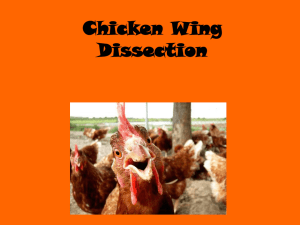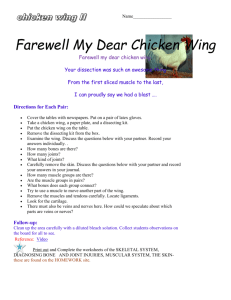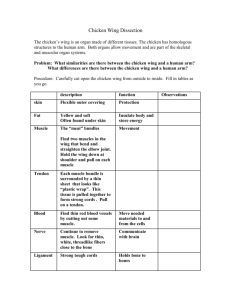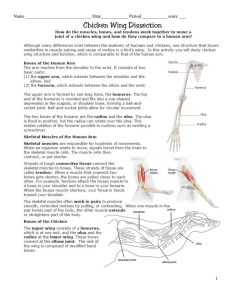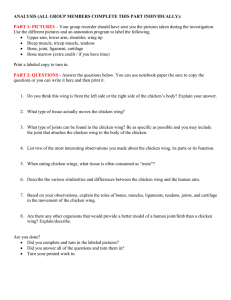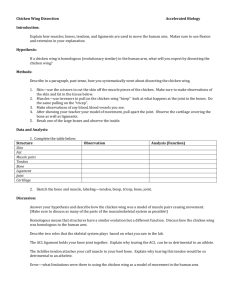Chicken Wing Dissection Guide - CGW-Life-Science
advertisement
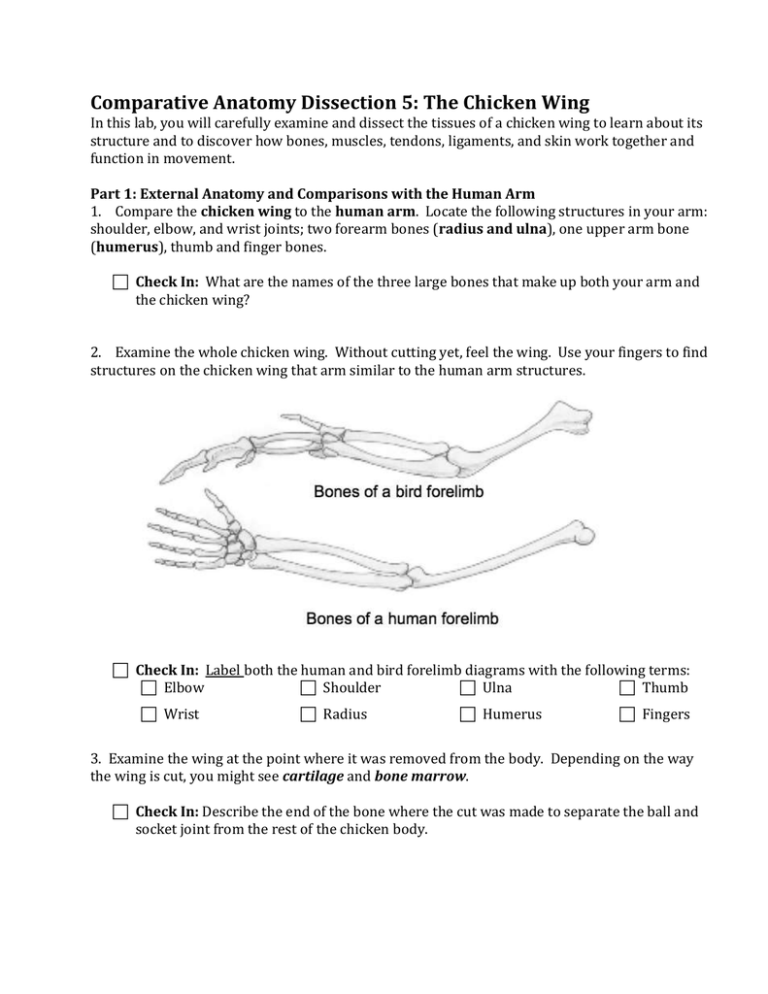
Comparative Anatomy Dissection 5: The Chicken Wing In this lab, you will carefully examine and dissect the tissues of a chicken wing to learn about its structure and to discover how bones, muscles, tendons, ligaments, and skin work together and function in movement. Part 1: External Anatomy and Comparisons with the Human Arm 1. Compare the chicken wing to the human arm. Locate the following structures in your arm: shoulder, elbow, and wrist joints; two forearm bones (radius and ulna), one upper arm bone (humerus), thumb and finger bones. Check In: What are the names of the three large bones that make up both your arm and the chicken wing? 2. Examine the whole chicken wing. Without cutting yet, feel the wing. Use your fingers to find structures on the chicken wing that arm similar to the human arm structures. Check In: Label both the human and bird forelimb diagrams with the following terms: Elbow Shoulder Ulna Thumb Wrist Radius Humerus Fingers 3. Examine the wing at the point where it was removed from the body. Depending on the way the wing is cut, you might see cartilage and bone marrow. Check In: Describe the end of the bone where the cut was made to separate the ball and socket joint from the rest of the chicken body. 4. Turn the wing so the inside is facing up. The “thumb” should be facing up. Use your forceps to pinch up the skin and make a small cut with your scissors down the middle of the skin. 5. Cut 1: Insert the scissors into the cut so that they are parallel to the bone. Try not to cut through the muscles below the skin [Keep the scissors pointed up like in the worm dissections]. Cut until you reach the shoulder joint. 6. Cut 2: Cut down the sides of the skin to make a T-shaped cut and peel the skin away from the muscle, using your forceps and probes. Look for yellowish tissue clumped together beneath the skin. This is fat tissue, made of fat cells. Cut 1 5. Observe the thin, transparent material that covers the muscles (meat). This material is called fascia. Fascia is dense fibrous connective tissue. It helps connects muscle to skin and also helps to separate the muscles from each other. 6. Expose both major joints of the chicken wing (wrist and elbow). IT WILL TAKE TIME AND EFFORT TO REMOVE THE SKIN. Be patient!!! Observe the tendons, blood vessels and muscle. Check In: What is the function of tendons? Check In: Of the three types of muscles (skeletal, smooth and cardiac), which two types of muscles are you looking at here AND how do you know? 7. When muscles contract, they pull on tendons, so when you pull on a tendon, you are modeling the action of a wing muscle. Use your forceps to pull on tendons individually. Try to get a part of your Chicken Wing to “wave” back and forth by pulling on tendons attached to two opposing muscles. Observation: Describe what happens to the bones and muscles of the chicken wing when you pull on a tendon with the forceps. 8. Use the mall probe to separate the biceps from the triceps BUT leave them attached to the humerus. 9. After separating the muscles, observe the ends of the bone and find the cartilage and ligament. Cartilage covers the ends of the bones. Ligaments connect the bones and look like white ribbons. 10. Break the bone with your fingers. Notice how resistant the bone was to bending. This is due to the collagen that makes the bone flexible. Examine the inside of the chicken bone. Use your teasing probe to explore the texture of the center of the bone (the marrow). Check In: What is the function of bone marrow? To dispose of your chicken wing, wrap all of the pieces and any pieces that you removed in a paper towel. Wipe off all tools with the wet wipes and put them away in the kit correctly. Throw away the chicken wing as directed by Mr. Spotts and wipe out your wax pan with another wet wipe. Answer the following Analysis Questions in the space provided on this sheet. This lab will be due on Friday 3 June, 2011. 1. Do you think this wing is from the left side or the right side of the chicken’s body? Explain your answer. 2. Describe any interesting observations you made about the chicken wing. Include names of bones and tissues in your description when possible. 3. Based on your observations, explain the roles of muscles, tendons, bones, and joints in the back-and-forth movement of the lower chicken wing.
